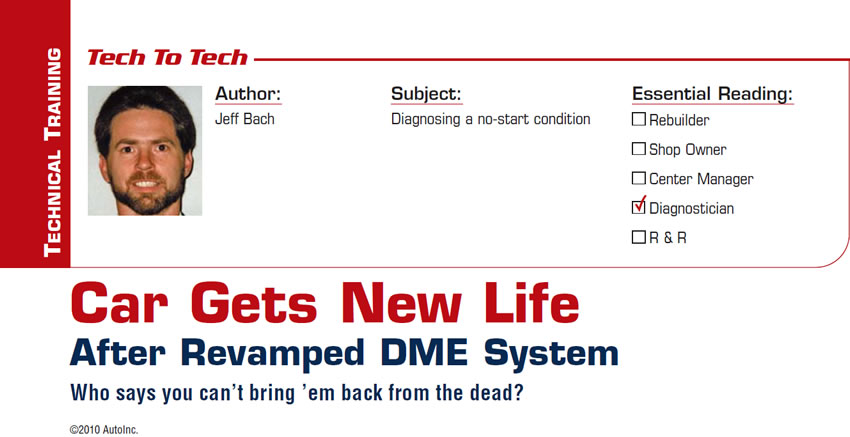Chrysler’s ‘Christmas Tree Stump’ Code
Chrysler transmissions have been difficult to diagnose for technicians since the beginning of electronic shift solenoids.
They use a separate transmission-control computer that is sometimes hard to read.

Dodge Caravan’s Sensor Goes Awry
I got a call recently from a friend of mine who runs a car shop, asking for help on a code for a cam sensor.
He had changed the sensor twice and double-checked the circuitry and even replaced the crank sensor. The powertrain control module (PCM) was the next stop, and it was a rather expensive one, so he asked me to take a look at the vehicle before he got a PCM to see if I could verify his diagnosis.

RAV4’s Transmission Dilemma Presents Challenge
The code chart for the P0770 shift-solenoid-E malfunction has a simple description of the diagnostic trouble code (DTC) checking condition: It says that the lockup does not occur during lockup range (50 mph) or lockup remains on during lockup-off range. The possible causes listed are that the shift-solenoid valve is stuck open or closed, the valve body is blocked or stuck, or the clutch is locked up.

Gen I Prius Crank No-Start Presents a Challenge
Crank no-start problems can be challenging when you’re dealing with a high-voltage (HV) battery. But specializing in hybrids has been one of the best decisions I’ve made. I have always enjoyed the challenge of working on “hard to find” drivability and electrical problems.
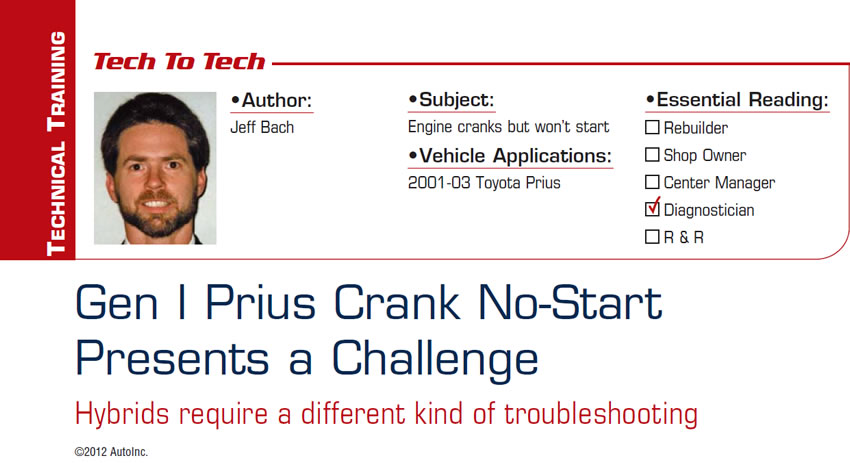
Even ‘Weird’ Troubleshooting Can Hold Lessons
“Wiring problems,” “shorts” and drains are words that act like a double-edged sword for me. They seem to be the place where otherwise competent technicians tend to draw the line when it comes to problems they enjoy working on. I understand why a lot of techs feel that way after seeing some of the weird problems I’ve encountered.

Everything but the Sink Fails to Fix ’98 Seville
When times get hard, people tend to do things themselves as much as possible before spending money to pay a professional. That’s completely understandable. It’s when they reach the point that it’s costing them more to do it themselves and yet they keep throwing money at the problem that I can’t understand. That’s the point where ego overrides logic. I guess once you get in so deep, it’s hard to cut your losses. It seems to me that it’s about the “twice-what-it-should-have-cost” point that I’ll get that phone call.
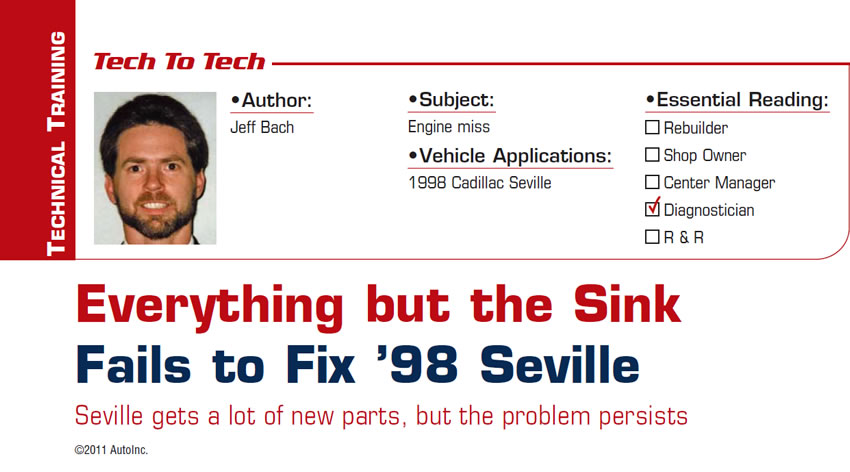
Troubled Continental Running ‘Rich’
The complaint on the car was that it ran terribly rich and the fuel mileage had gone down to about 8 mpg. The car had been to two independent shops and, last, at the Ford dealer. It had had both O2 sensors replaced and two electronic control units (ECUs) installed. The dealer told the owner that the car was getting as good a gas mileage as it was going to get. They had installed a new ECU because they said the one that was in it was an aftermarket part and wouldn’t work properly. The car was not setting any codes, but the sooty exhaust made it obvious that it was running pig rich. A scan check revealed that the engine was reaching operating temperature, the manifold-air-pressure (MAP) sensor was working, the engine was in closed loop, and the O2 readings were showing lean. I got the image in Figure 1 by connecting one channel of my scope to one of the O2 sensors and the other channel to the injector signal at the ECU.

Driveway Fixes not Always Easy
In this day and age of technology, most of the problems motorists encounter can be found on a “fix database” somewhere. The more everyone relies on these fixes, however, the less we technicians are needed to troubleshoot problems. Technicians are not the only ones looking for fixes on the Internet. “Do-it-yourselfers,” as well as many car owners who are caught in the current economic crunch, are finding their own solutions on the Internet with simple Google searches.
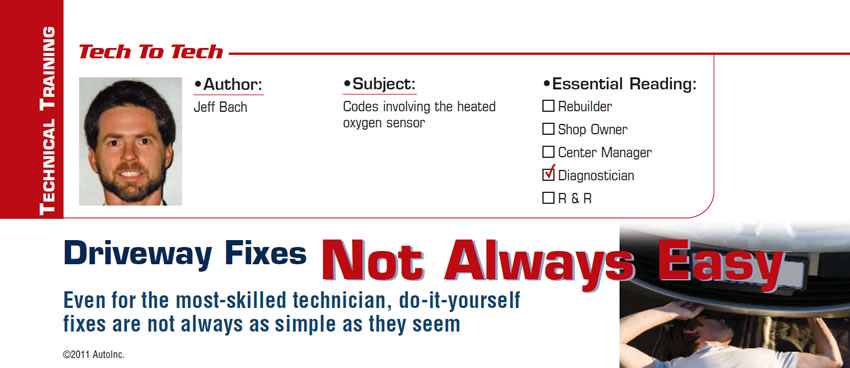
Reflashing Job Takes a Different Turn
He goes on to explain that it is a 2002 PT Cruiser, and it starts overheating whenever he runs the A/C and sits in traffic. He traced it down to the fan relay and replaced it with a new one. Apparently that solution didn’t work, so he was trying to bypass the relay to get it to turn on the fan, and smoke started coming out of the computer. So he got a used [computer] and put it in but it still wouldn’t start. He said D.J. said it needed to be flashed and that I could do that. He added, “I could bring it to you, as I already have it loaded on a trailer.”
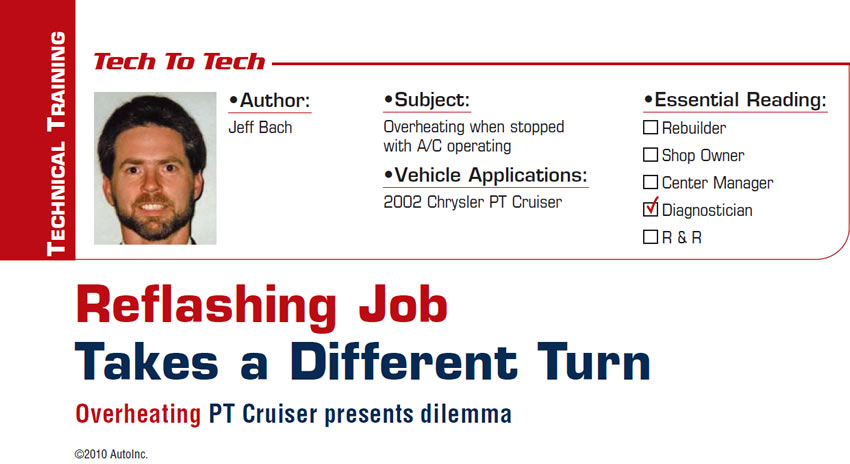
F-150 Throttle’s Sensor Goes Amuck
Seemingly subtle variances in signals from sensors can trigger major changes in fuel and emission controls. Such was the case in my most-recent adventure into solving a drivability problem for a friend who owns a shop across town from me. This fellow doesn’t give up on problem jobs and sends cars to the dealer only for absolutely necessary things such as programming of computers. When we discussed the problem he was having with this 2004 Ford F-150 5.4 engine, it sounded like a problem that wouldn’t be too difficult to resolve.

Grand Am No-Start Presents Challenge
I haven’t thought about that dream for a long time. Then I found myself working on this ’93 Pontiac Grand Am no-start. It’s a 3.3-liter V-6. It has the characteristic look of a car that has been saved for slow times, judging from the rusty belt (Figure 1).

Car Gets New Life After Revamped DME System
The car sitting in front of my bay was towed in last night for a no-start problem. Looking at it gives me that “Here-I-go-again” feeling. The chalky paint is oxidized from infrared overexposure. A greenish hue of lichens blankets the exposed upper surfaces. The tags have been expired for two years. Disturbed ants crawl along the inner fender seam, originating from a bra that covers the front of the vehicle. There are no leaves or maple seeds in the cowl vents, so I assume it might have been residing in an apartment complex (covered parking) or perhaps a subdivision.
